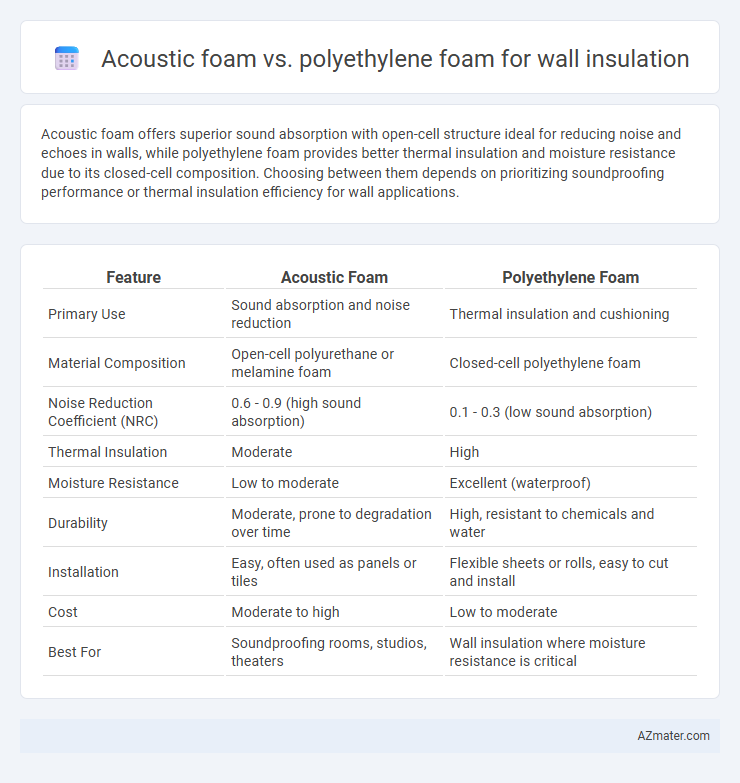Acoustic foam offers superior sound absorption with open-cell structure ideal for reducing noise and echoes in walls, while polyethylene foam provides better thermal insulation and moisture resistance due to its closed-cell composition. Choosing between them depends on prioritizing soundproofing performance or thermal insulation efficiency for wall applications.
Table of Comparison
| Feature | Acoustic Foam | Polyethylene Foam |
|---|---|---|
| Primary Use | Sound absorption and noise reduction | Thermal insulation and cushioning |
| Material Composition | Open-cell polyurethane or melamine foam | Closed-cell polyethylene foam |
| Noise Reduction Coefficient (NRC) | 0.6 - 0.9 (high sound absorption) | 0.1 - 0.3 (low sound absorption) |
| Thermal Insulation | Moderate | High |
| Moisture Resistance | Low to moderate | Excellent (waterproof) |
| Durability | Moderate, prone to degradation over time | High, resistant to chemicals and water |
| Installation | Easy, often used as panels or tiles | Flexible sheets or rolls, easy to cut and install |
| Cost | Moderate to high | Low to moderate |
| Best For | Soundproofing rooms, studios, theaters | Wall insulation where moisture resistance is critical |
Introduction to Acoustic Foam and Polyethylene Foam
Acoustic foam is a highly porous material designed to absorb sound waves, reducing echo and noise levels in indoor environments, often made from polyurethane or melamine. Polyethylene foam, a closed-cell foam, offers excellent thermal insulation and moisture resistance but has limited sound absorption properties compared to acoustic foam. The choice between acoustic foam and polyethylene foam for wall insulation depends on whether the primary goal is sound control or thermal insulation.
Key Differences in Material Composition
Acoustic foam is primarily composed of open-cell polyurethane or melamine, designed to absorb sound waves and reduce noise by trapping air within its porous structure. Polyethylene foam consists of closed-cell polyethylene, offering superior moisture resistance and thermal insulation but limited sound absorption due to its dense and impermeable composition. The key distinction lies in acoustic foam's porous organic polymers optimized for soundproofing, while polyethylene foam's closed-cell plastic structure emphasizes durability and moisture barrier properties.
Sound Insulation Performance Comparison
Acoustic foam offers superior sound absorption by trapping mid to high-frequency noise, making it ideal for reducing echo and reverberation in indoor environments. Polyethylene foam provides excellent sound insulation through its dense, closed-cell structure, effectively blocking airborne noise and thermal transfer. For comprehensive wall insulation, combining acoustic foam's absorption qualities with polyethylene foam's barrier properties optimizes overall soundproofing performance.
Thermal Insulation Efficiency
Acoustic foam typically provides moderate thermal insulation due to its open-cell structure, which traps air but allows some heat transfer, making it more effective for sound absorption than thermal resistance. Polyethylene foam, with its closed-cell structure, delivers superior thermal insulation by minimizing heat conduction and preventing moisture penetration, making it highly efficient for wall insulation applications. For optimal thermal performance, polyethylene foam is preferred over acoustic foam, especially in environments requiring strong thermal barriers.
Installation Methods and Ease
Acoustic foam typically features peel-and-stick or adhesive backing, enabling straightforward installation directly onto walls, often requiring minimal tools and effort. Polyethylene foam panels usually demand mounting with mechanical fasteners, such as screws or anchors, making the installation process more labor-intensive and time-consuming. The lightweight and flexible nature of acoustic foam generally results in easier and quicker application compared to the denser, more rigid polyethylene foam insulation.
Durability and Longevity
Acoustic foam offers excellent sound absorption but tends to degrade faster under UV exposure and physical wear compared to polyethylene foam, which boasts superior durability and resistance to moisture, chemicals, and impact. Polyethylene foam's closed-cell structure ensures long-term performance and sustained insulation benefits in various environmental conditions. Choosing polyethylene foam enhances wall insulation longevity, especially in demanding or humid environments where durability is crucial.
Moisture and Fire Resistance
Acoustic foam typically offers moderate moisture resistance but struggles with high humidity environments, making it prone to mold and mildew without proper ventilation. Polyethylene foam boasts superior moisture resistance due to its closed-cell structure, effectively preventing water absorption and enhancing durability in damp conditions. Fire resistance varies significantly; many acoustic foams are treated with fire retardants but often rank lower in fire safety compared to polyethylene foam, which inherently has better flame retardant properties and meets stricter fire safety standards.
Cost Analysis and Budget Considerations
Acoustic foam generally offers superior sound absorption properties ideal for reducing echo and noise, while polyethylene foam provides better thermal insulation with moisture resistance at a lower cost per square foot. Cost analysis reveals acoustic foam typically ranges from $2 to $5 per square foot, making it a premium choice for sound control, whereas polyethylene foam costs between $1 and $2 per square foot, suited for budget-conscious insulation projects. Budget considerations should weigh the primary insulation goals--acoustic versus thermal performance--along with installation expenses and long-term energy savings to determine the most cost-effective solution.
Environmental Impact and Sustainability
Acoustic foam, typically made from polyurethane, often contains chemicals that are less biodegradable and may emit volatile organic compounds (VOCs), impacting indoor air quality and environmental health. Polyethylene foam, derived from petrochemicals but more recyclable and less prone to off-gassing, offers a comparatively lower environmental footprint when managed through proper recycling streams. Choosing polyethylene foam for wall insulation supports improved sustainability due to its recyclability and longer lifecycle, while acoustic foam prioritizes sound absorption but poses greater challenges in waste management and environmental impact.
Best Applications: Choosing the Right Foam for Wall Insulation
Acoustic foam is ideal for sound absorption in recording studios, home theaters, and office spaces, reducing echo and improving audio clarity through its open-cell structure. Polyethylene foam excels in thermal insulation and moisture resistance, making it suitable for exterior walls, basements, and areas prone to dampness or temperature fluctuations. Selecting the right foam depends on whether soundproofing or thermal protection is the primary goal, with acoustic foam optimizing noise control and polyethylene foam providing durable, moisture-resistant insulation.

Infographic: Acoustic foam vs Polyethylene foam for Wall insulation
 azmater.com
azmater.com